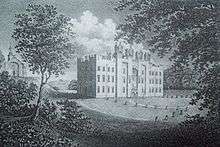Baron Lucy
.svg.png)
The canting arms of the Anglo-Norman de Lucy (or de Luci) family display three Esox lucius
Baron Lucy (anciently Lucie or Luci) is a title that has been created four times, three times by tenure and once by writ,[1] which means that the peerages could descend through both male and female lines. The first creation by tenure came in the 12th century with Chief Justiciar Richard de Luci. In 1320, the title Baron Lucy was created in the Peerage of England by writ of summons dated 15 May 1320.[2] The title Baron Lucy has been dormant since 1398.[3]

Hylton Castle and St Catherine's Chapel (on the left); unknown artist, c. 1800
Barons de Lucy
Barons de Lucy (also Lucie or Luci) by tenure
- Richard de Luci, Governor of Faleis (Normandy), Lord of Diss, Chief Justiciar of England (died 1179)
- Richard de Luci, son of Geoffrey de Luci, 2nd and last Baron Lucy by tenure (died ante 1196)
Barons de Lucy/Luci (of Egremont) by tenure
- Reginald de Luci, Lord of Egremont (died ante 1199)
- Richard de Luci, Reginald's son, Lord of Egremont (died 1213)
Barons de Lucy (of Cockermouth) by writ (1320)
- Anthony de Lucy, 1st Baron Lucy (died 1343)
- Thomas de Lucy, (Anthony's son), 2nd Baron Lucy (d.1365)
- Anthony de Lucy, 3rd Baron Lucy (d.1368)
- Joan de Lucy, (daughter of Anthony, 3rd Baron), 4th Baroness Lucy (d.1369 in infancy)
- Maud de Umfraville, (sister of Anthony, 3rd Baron), 5th Baroness Lucy, Countess of Angus (d.1398). Following her death on 24 Dec 1398 the peerage became dormant. [4]
See also
Notes
- ↑ Nicholas Harris Nicolas, William Courthope, The historic peerage of England, John Murray, London 1857, p. 302
- ↑ John Burke, A general and heraldic dictionary of the peerages of England, Ireland, and Scotland, extinct, dormant, and in abeyance, Henry Colburn & Richard Bentley, London 1831, p. 323
- ↑
- ↑ Grant, Alexander (2014). "The St Bees lord and lady, and their lineage". In Keith J. Stringer. North-West England from the Romans to the Tudors : essays in memory of John Macnair Todd. Extra series no. XLI. Carlisle: Cumberland and Westmorland Antiquarian and Archaeological Society. pp. xviii, 288, p.179–181. ISBN 9781873124659.
References
Bibliography
- John Burke, A general and heraldic dictionary of the peerages of England, Ireland, and Scotland, extinct, dormant, and in abeyance, Henry Colburn & Richard Bentley, London 1831
- Nicholas Harris, William Courthope, The historic peerage of England, John Murray, London 1857
This article is issued from Wikipedia - version of the 9/11/2016. The text is available under the Creative Commons Attribution/Share Alike but additional terms may apply for the media files.